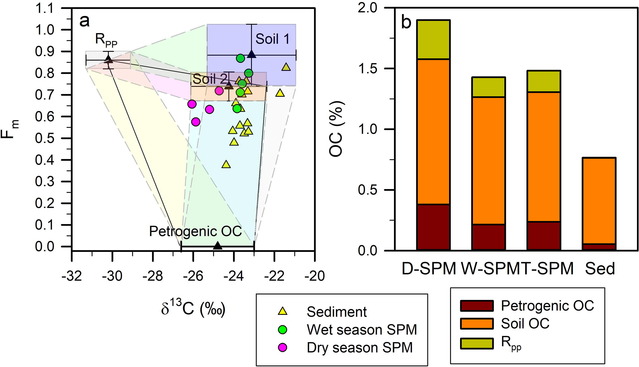Baozhi Lina,b, Zhifei Liua*,Timothy I. Eglintonb*, Selvaraj Kandasamyc, Thomas M. Blattmannb, Negar Haghipourb,d, Gert J de Langea,e
a State Key Laboratory of Marine Geology, Tongji University, Shanghai 200092, China
b Geological Institute, Department of Earth Sciences, ETH Zürich, 8092 Zürich, Switzerland
c Department of Geological Oceanography and State Key Laboratory of Marine Environmental Science, Xiamen University, Xiamen 361102, China
d Laboratory of Ion Beam Physics, ETH Zürich, Otto-Stern-Weg 5, 8093 Zürich, Switzerland
e Department of Earth Science-Geochemistry, Geosciences, Utrecht University, 3584 CD, Utrecht, The Netherlands
*Corresponding authors. E-mail address: lzhifei@tongji.edu.cn (Z. Liu) and timothy.eglinton@erdw.ethz.ch (T.I. Eglinton).
Abstract
Large river systems accumulate, process, and transport huge quantities of organic matter (OM) from their catchments, part of which is exported to the ocean. Although this suite of processes comprises an important component of the global carbon cycle, integrated studies examining the nature and extent of OM processing on a basin-wide scale remain rare. Here, we provide an overview of provenance and composition of OM in suspended and deposited sediments within the Pearl River watershed in South China. We present new data on the organic carbon (OC) and total nitrogen (TN) contents, stable carbon and radiocarbon isotopic compositions of OC (δ13C and Fm), as well as grain size distribution and mineral-specific surface area of Pearl River sediments. These results are combined with published data on suspended particulate matter (SPM) and soil profiles in the Pearl River watershed in order to determine the provenance and transformation of OM in this large subtropical fluvial system.
We find that the low 14C contents, expressed as fraction modern (Fm) values, in suspended (Fm: 0.58–0.87) and sedimentary OM (Fm: 0.38–0.82) are attributed to contributions from 14C-depleted soils, bedrock, as well as riverine primary productivity (Rpp) that utilizes 14C-depleted sources of dissolved inorganic carbon (DIC). For SPM, soil OM (Fm: 0.87±0.13) is inferred to be the dominant fraction during the wet season, whereas the contributions of Rpp (Fm: 0.86±0.04) and petrogenic OC (devoid of 14C) are enhanced during the dry season. This manifests itself in differences in OCsoil, OCRpp, and OCpetro contributions in SPM between wet and dry seasons (1.05±0.18 vs. 1.20±0.50%, 0.16±0.03 vs. 0.32±0.15% and 0.21±0.07 vs. 0.38±0.19%). During erosion and transport, the most labile OM in the top soil is rapidly degraded, as indicated by a stronger contribution from soil CO2 into riverine DIC during the wet season and flood event (39±1% and 45±3%) compared to the dry season (31±2%). River sediments are primarily accumulated during the wet season when suspended sediment fluxes are high. Refractory deep soil OM (Fm: 0.74±0.07) dominate in these sediments, whereas moderately labile soil OM components are further degraded during settling and storage. This sedimentary OM is predominantly composed of aged soil (92±4%), with a minor contribution from bedrock (7±4%) and negligible input from Rpp (0.2±0%). The longitudinal changes in the composition of suspended and sedimentary OM are mainly controlled by input of Rpp and ongoing degradation processes in the river system. The riverine particulate OC flux to the Pearl River estuary and ocean thus contains a mixture of soil, petrogenic and Rpp OM, all exhibiting relatively low Fm values. The riverine OM transformation and dynamics are important for the short-term carbon cycle, whereas the remaining signature and fate of the extensively processed, refractory OM has implications for the long-term carbon cycle.

Full Article:https://www.sciencedirect.com/science/article/pii/S0016703719303576


